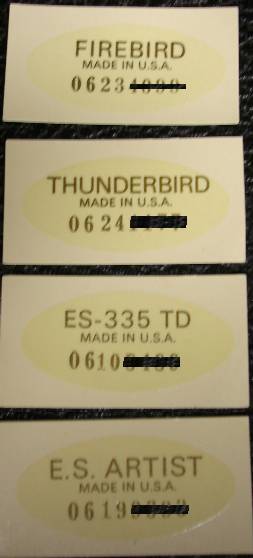Gibson Serial Numbers 70s

Discussion Forum. Want to hide these. The only Gibson serial number system I am familiar with. The serial numbers Gibson used during the '70s are confusing to. Gibson serial numbers, from February 1961 until 1970. For all models, the serial number on the back of the headstock is stamped. Some serial numbers are duplicated from 1963 to 1969.

As one of the oldest and most widely recognized brands in music, has crafted some of the most cherished and valuable instruments of all time. Determining exactly when your Gibson specimen was made can have high stakes attached to it. A difference of only one year - sometimes even several months - can mean a four-figure difference in value. Our hope is to make the dating process and, in turn, the valuation as easy, accurate and transparent as possible. You should be able to use this guide to determine the year of your instrument and then consult the to find its value, all for free. Methods For Dating a Gibson Instrument For many vintage instruments, determining the date of manufacture involves little more than running the serial number through a reference guide.
Whereas Martin guitars have been using a single, consistent numbering system since the 19th century, Gibson has used several different serial number formats since its inception in 1902, meaning that some formats and numbers overlap across decades. This makes it especially important to first identify the general era during which your instrument was made before pinning down the exact date of manufacture with a serial number. If you know the backstory around when the instrument was purchased, this can provide some rough clues about its era. The most general physical piece of evidence on the instrument, however, is going to be the logo on the headstock. Gibson Headstock Logos Through The Decades Here's a look at the different logos Gibson used during each major era of manufacturing.
1902 to Late 1920s. 1932 L-2 The script logo continues without the slant. Some flattop guitars of this era started to omit the word 'The' from the inlay. 1933 - 1947 By 1933 Gibson had dropped the 'The' from all of their logos while retaining the script 'Gibson.'
The original thin script was replaced with a thicker font on higher-end models in the mid-’30s, and across the entire lineup by the end of the decade. From 1943 to 1947, the logo was a thick golden script, known as the banner logo. Some models (LG-2, J-45, SJ, select L-50s) included an actual banner reading 'Only a Gibson Is Good Enough' in the middle of the headstock. 1969 SG Custom Gibson stopped dotting the i in their logo on some of their instruments. Most models get a dotted i again in 1972, with the rest following suit from 1981 onward.
Other Date-Linked Features Aside from the logos, each era of manufacturing included certain identifying traits such as the hardware (tuners, knobs, plates, etc.), the pickups, the type of finish, and the electronics inside that can give clues as to when an instrument was made. But not a final verdict. Many older instruments may have reproduction or other non-original parts, including a non-original finish. Download Lagu Shima Ke Pangkuanmu.
This makes relying entirely on the physical features of a guitar potentially misleading. The thickness of the headstock, however, is not as vulnerable to modification or replacement. Before mid-1950, most Gibson headstocks were thinner at the top when looked at from a side profile. After 1950, headstocks had uniform thickness. Dating a Gibson by Factory Order Number (FON) Gibson has historically used two different alpha-numerical formats to catalog its instruments: serial numbers and FONs (Factory Order Numbers).